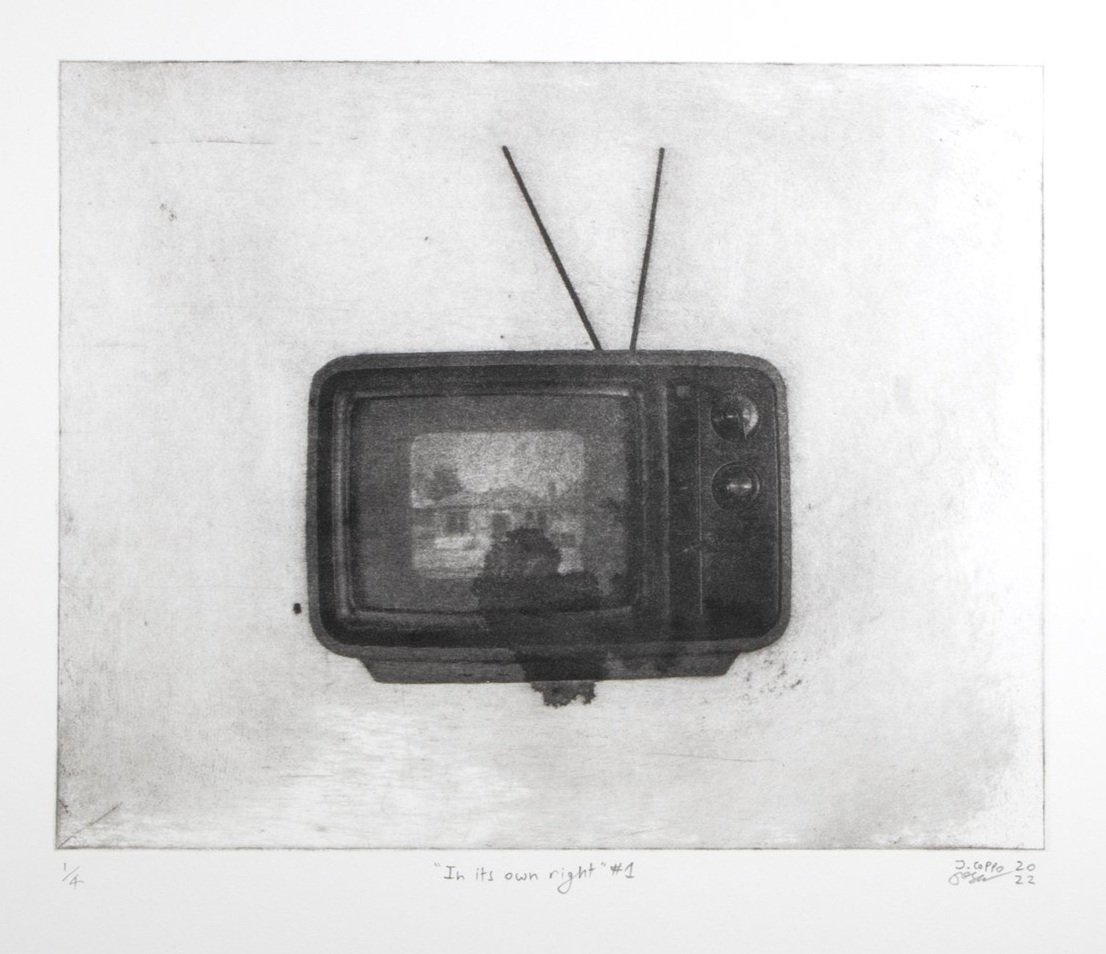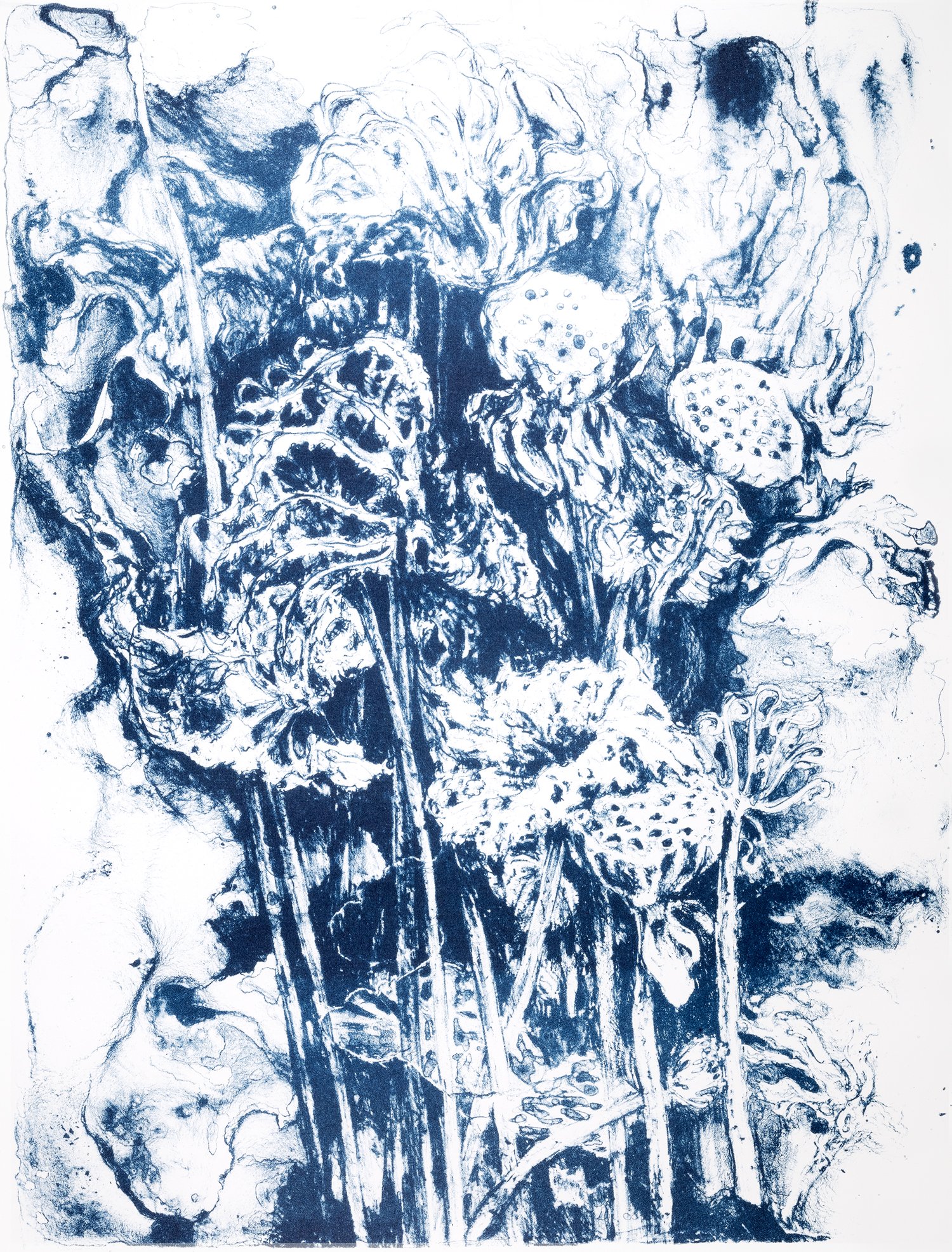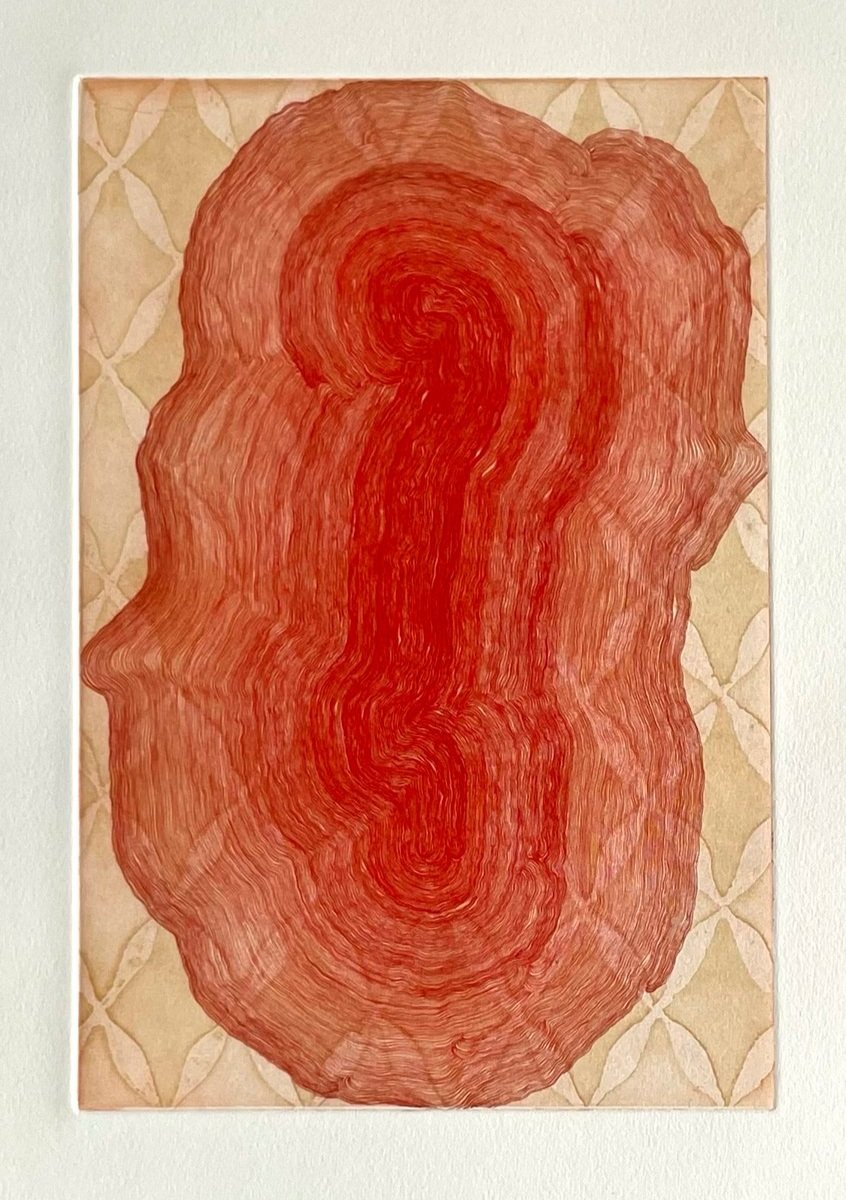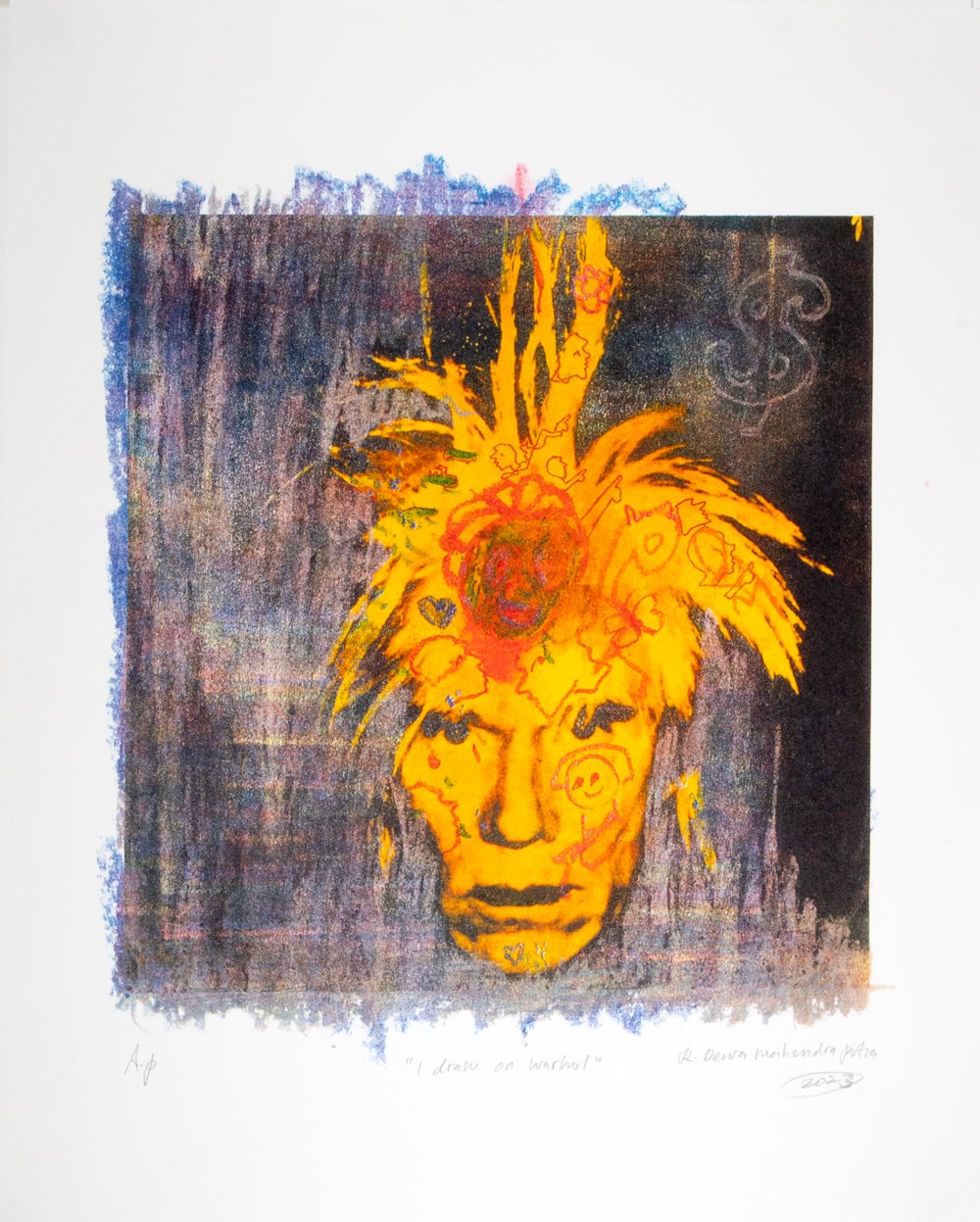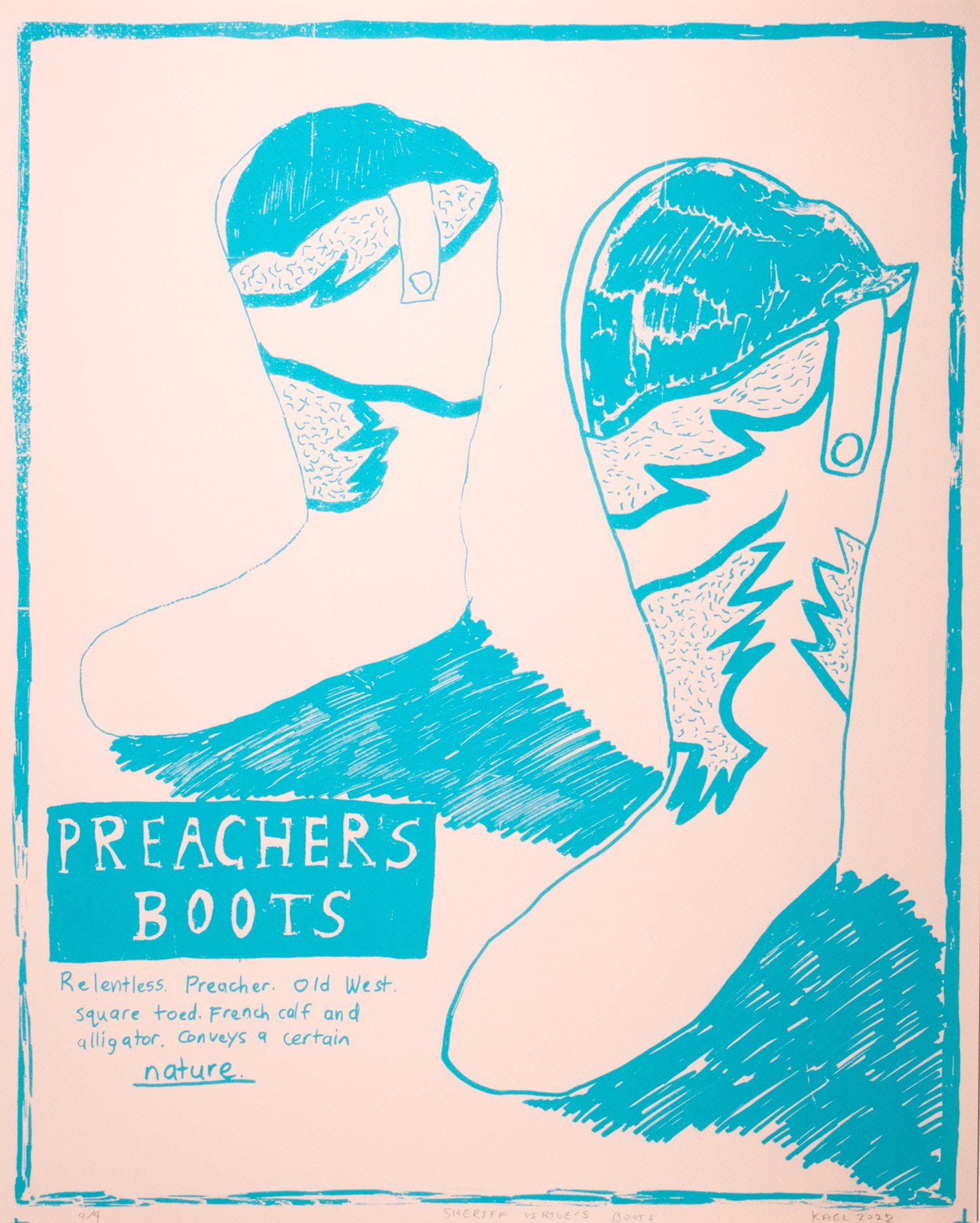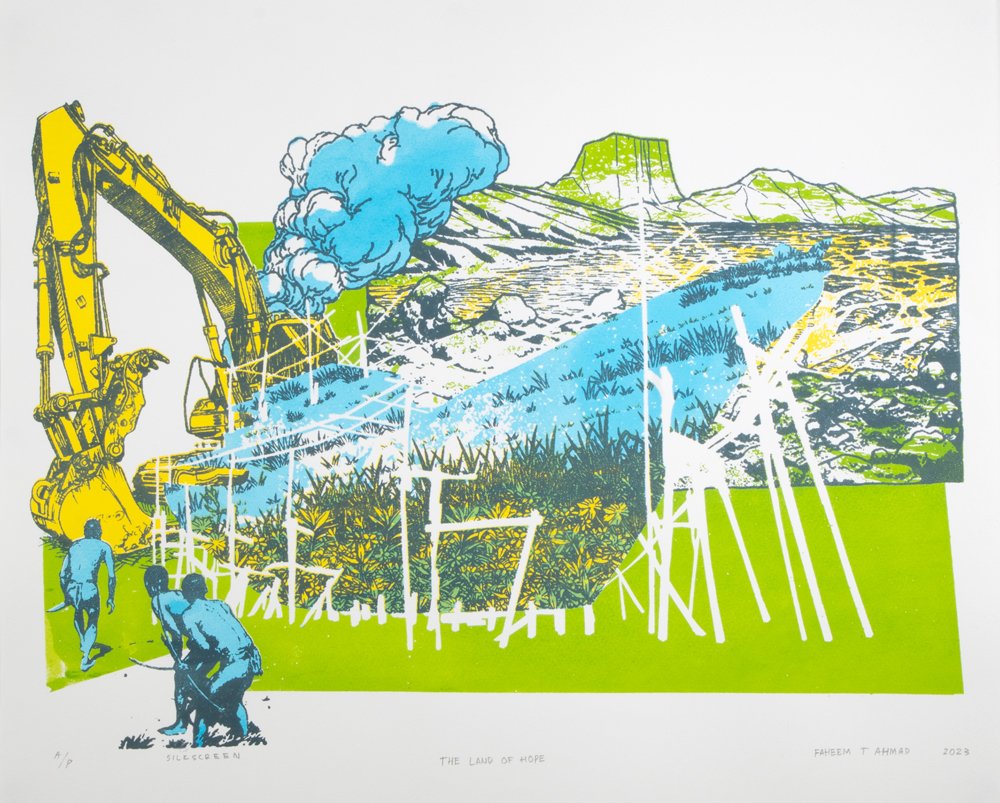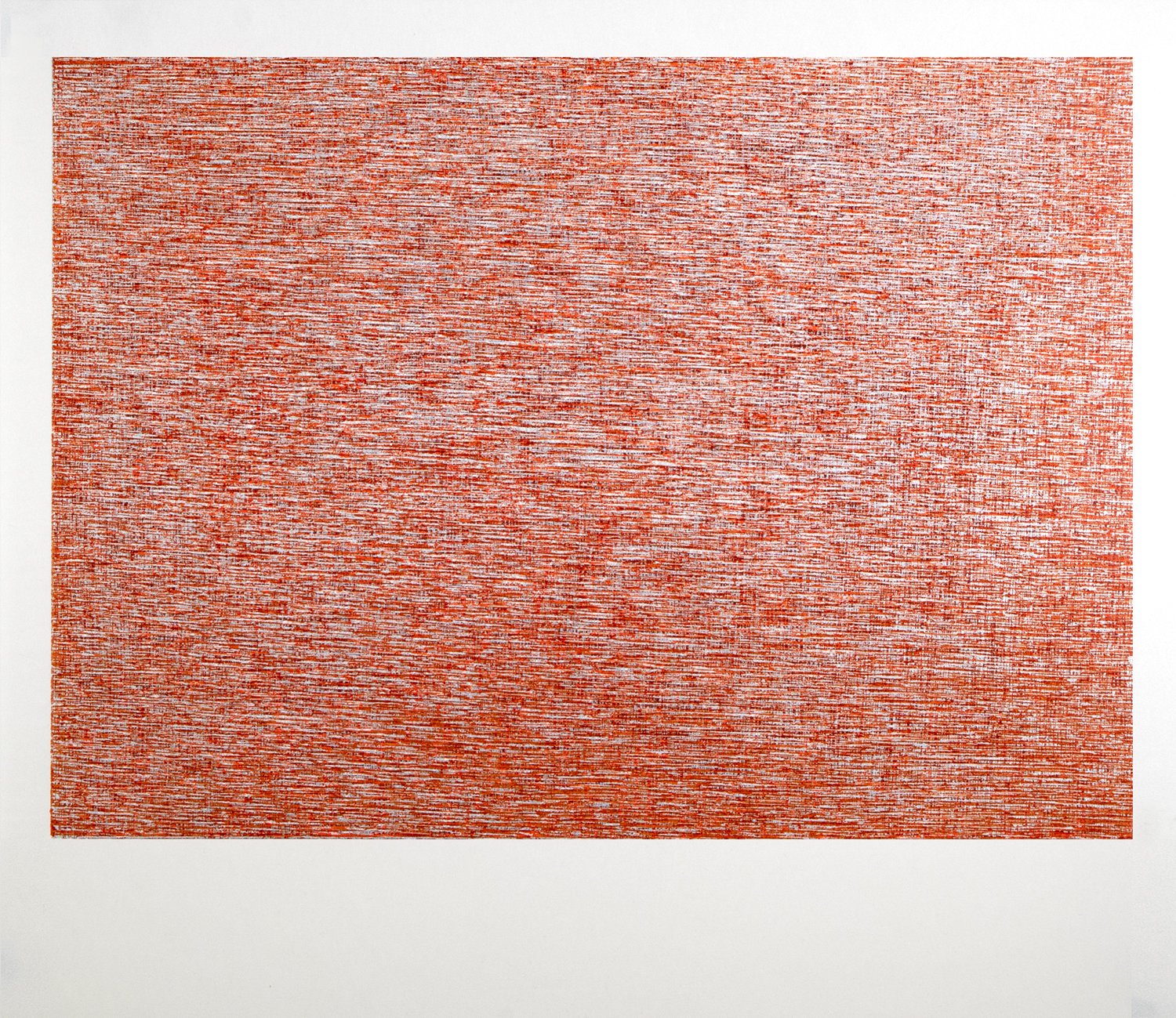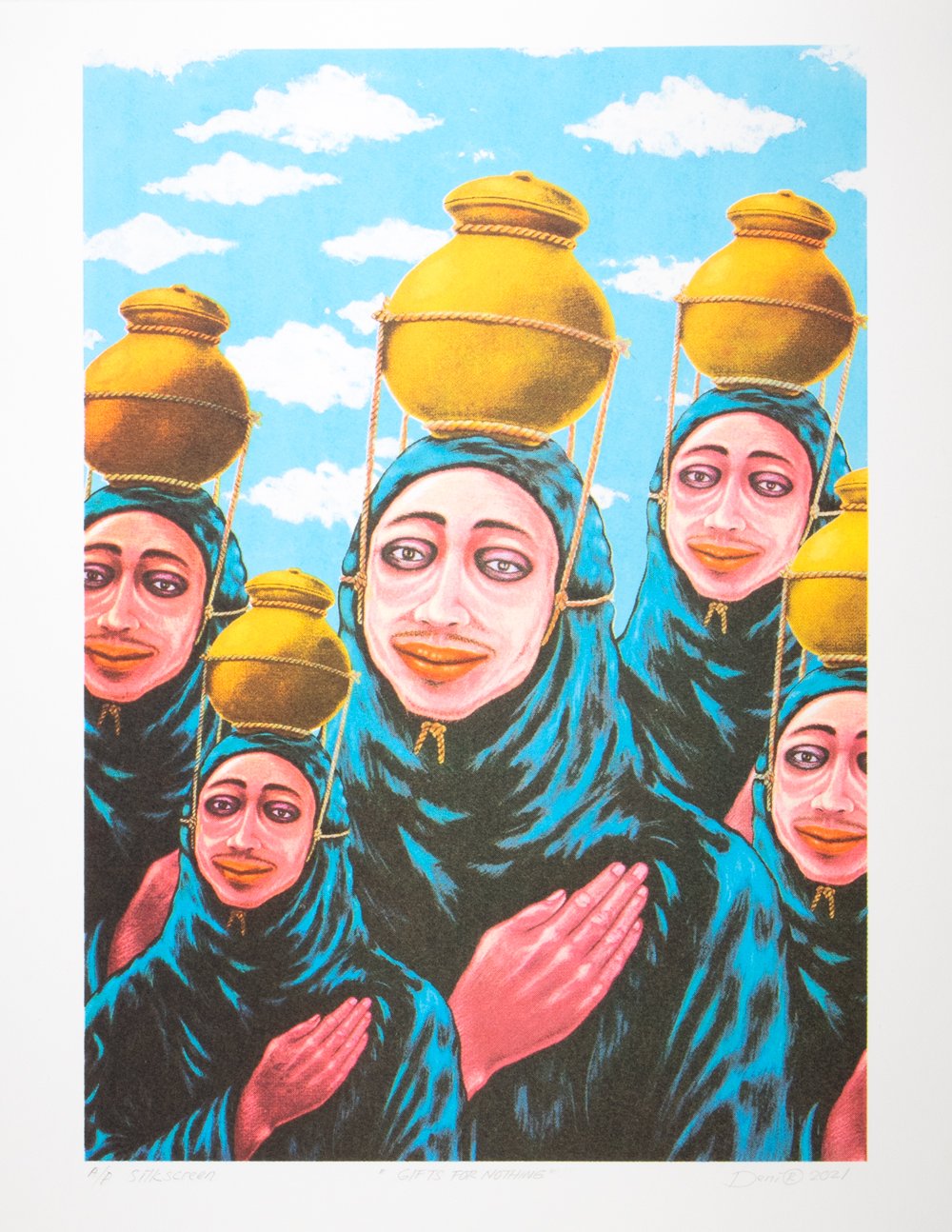Education Resources for Teachers and Students
Download the full education kit here
Joshua Copland-Nielsen, In its own right #1 2022, 50 x 45 cm
DISRUPTION: DISCOURSE AND
EXCHANGE
An exhibition showcasing prints from
four art schools in Australia and
southeast Asia.
Disruption: Discourse and Exchange is an example of prominent art institutions engaging in a sophisticated dialogue through the medium of printmaking. The exhibition comprises of four lead practitioners and selected students from their program, each having created a single print at a specific size interpreting the theme of disruption to transmit knowledge through the specificity of the medium and develop relations for future projects and mutual support. From four institutions–the Institut Seni Indonesia Surakarta (Surakarta, Indonesia), King Mongkut’s Institute of Technology Ladkrabang (Bangkok, Thailand), National Art School (Sydney, Australia) and Queensland College of Art (Brisbane, Australia), all prints communicate the depth of research and practice in the Asia Pacific region. Sharing their echo artefacts–their disruptions–gifts the materiality of their research across national and cultural borders to see how print as knowledge is performed politically, socially and conceptually. The prints selected in this education resource invite school students to examine the history of printmaking as a form of insurrection, disturbance, and radicalism (both political and material). Questions and activities invite students to engage with individual artworks and the exhibition in its entirety, to explore approaches that extend the tradition of papermaking and papercutting into new arenas. Students are encouraged to make significant connections between these artists and the wider study of art history.
Scroll down for suggestions and activities for teachers and students.
An Introduction to the Exhibition
The Disruption print folio delves into the profound significance of printmaking as a medium of communication. It emerged during COVID-19 as a collaborative initiative to exchange ideas and engage in material discourse across the region, overcoming the barriers imposed by the pandemic. By exploring the tactile certainty inherent in printmaking, the folio sheds light on the relevance of this traditional art form amidst a contemporary landscape characterised by image flux and the overwhelming presence of digital media. The exchange of works presented in this folio go beyond the exchange of physical artefacts. It serves as a conduit for sharing cultural knowledge and instils a sense of commitment and obligation. The ownership of another artist’s work obliges the recipient to care for and honour the lineage of the artwork, encompassing both the artist’s creative vision and the cultural context from which it emerges. Through this process, folios become catalysts for building community relationships and repositories of research knowledge and artistic power. They enable students to forge connections between image-making and the various technologies embedded in different cultural landscapes. In its copy and trace protocols, printmaking serves as a conduit for engaging with contemporary culture and evoking meaning. The ontological trio described by Sir Francis Bacon–the press, the compass and the canon–underpin the expansion of capitalism. This legacy allows printmakers to critically reflect on and disrupt the repetitive nature of cultural hegemony through the very means of production itself.
THE ART SCHOOLS
Institut Seni Indonesia Surakarta, Indonesia
Theresia Agustina Sitompul
Lecturer, Institut Seni Surakarta, Surakarta, Indonesia
Theresia (Tere) Agustina Sitompul is an artist from Yogyakarta and completed her BA and Postgraduate degree in Printmaking at the Indonesian Institute of Art. She is the co-founder and the only female member of Grafis Minggiran, a printmaking collective in Yogyakarta established in 2001, and is also a printmaking lecturer at the Institut Seni Surakarta, Surakarta. Tere explores the nature of human agency within increasingly complex socio-cultural interactions. Between concepts of maternity and religious or cultural forces, Tere asks to what extent are the decisions we make for our children are justified with the intentions of good parenting? Tere participated in ArtJog in 2014, 2016 and 2018 after winning an ArtJog Young Artist Award in 2013. In the same year Tere was a Sovereign Asian Art Prize finalist. Her work has been exhibited in Art Jakarta since 2011, and in 2018 she was one of 10 prominent artists included in Art Jakarta’s 10-year anniversary presentation.
Deni Rahman
Lecturer, Institut Seni Surakarta, Surakarta, Indonesia
Born in 1979 in Jakarta, Deni Rahman is a print artist and a lecturer at the Indonesia Institute of Arts (ISI). Upon his graduation from the Department of Fine Arts (Printmaking) in Yogyakarta, he started to work on the development of printmaking, particularly the intaglio technique. Deni is also a member of Minggiran Graphic Studio, an art group that initiated Yogyakarta Graphic Art Week in 2017 to promote graphic arts to a wider audience.
King Mongkut’s Institute of Technology Ladkrabang,
Bangkok, Thailand
Asst. Prof. Tanasan Pattanasuttichonlakun
Head of Printmaking, King Mongkut’s Institute of Technology Ladkrabang, Bangkok, Thailand
Born in 1974, Tanasan’s interest in printmaking art derived from his first Mono Print during high school. It depicted a traced technique that created an abstract aesthetic related to scientific experiments in art. Since then, he has repeatedly contemplated printmaking as an artform. Tanasan received a Bachelor of Fine Arts (Printmaking) from the Faculty of Architecture, King Mongkut’s Institute of Technology Ladkrabang, Bangkok, Thailand in 2002. In 2004 he earned a Master of Fine Arts (Printmaking) from Graduate School in the Faculty of Painting, Sculpture and Graphic Arts, Silpakorn University, Bangkok, Thailand. Most of his works employ the serigraphy printing technique. Presently, Tanasan continues his interests in learning and exchanging with both local and foreign printmaking artists to gain more creative knowledge and experiences in printmaking.
National Art School of Australia, Sydney, Australia
Dr Carolyn McKenzie-Craig
Head of Printmaking Lecturer National Art School, Sydney, Australia
BFA Griffith University, BFA (Hons) Griffith University, PhD (QCA) Griffith University
Carolyn is an interdisciplinary artist examining body gesture and language through performative processes and print practices. She is currently a board member for Frontyard ARI, Marrickville and teaches at the National Art School, Sydney. She is currently represented by May Space, Sydney. Carolyn’s interests and areas of specialization include gender and typological representations, photo discourse and history, drawing ontologies, contemporary print-media and social praxis and contemporary art. She is a Director at Frontyard Projects and Schmick Contemporary. Her work is held in significant collections such as the National Gallery of Australia, Burnie Regional, Swan Hill, Mackay, Cairns Regional and Griffith Artworks.
Queensland College of Art, Brisbane, Australia
Dr Tim Mosely
Lecturer in Fine Art, Convenor Print, Queensland College of Art, Griffith University, Brisbane, Australia
PhD (QCA) Griffith
Tim Mosely’s art practice considers humanity’s relationship with wilderness (the bush), drawing on the autographic and indexical nature of papermaking, prints and books to investigate that relationship. His work contributes to the fields of print culture, artists book practice and haptic aesthetics. With a strong focus on printmaking in his education, his artists books have been exhibited in significant survey exhibitions and are held in prominent national and international artists books collections. He convenes and teaches in the print program at Queensland College of Art, Griffith University, and co-ordinates the artists book Brisbane events (abbe).
Donruethai Chlomruk, Beginning of Time I 2023, 50 x 45 cm
Dian Darmansjah, An unremarkable journey (footpath to frontdoor) 2022, multi plate etching, 50 x 45 cm
For Teachers
Disruption: Discourse and Exchange presents exciting opportunities to integrate new works by contemporary Southeast Asian printmakers into existing curricula and case study investigations. The exhibition gives insight into practising artists and academics, spotlighting how they can use contemporary printmaking methodologies to create artworks that the history of print media and its greater impact on the communication, culture, and societal progression. The artists speak first and foremost from an era of image flux and the overwhelming presence of digital media, drawing attention to the ‘tactile certainty inherent in printmaking’. Collectively, sharing folios as a source discourse roots the exhibition in a larger historical conversation on the power of art making to go beyond an object of information and onto an ongoing exchange of power, thought or connection.
Suggestions for Teaching and Learning
Consider examining the exhibition as an in-depth focus study within a broader investigation of Printmaking as a Language, Printmaking and Symbolism, Art Activism, Print in History or Printmaking as Material Dialogue.
Through these lenses students can investigate the exhibition to examine printmakers as newsbreakers, risk-takers, social provocateurs and educators. The artists display a vastness in material practice working across different machinery and with individual processes that invite a highly intimate relationship with their works and the message in which is transferred. Each explores personal themes and symbols to communicate their interpretation of disruption and teachers are encouraged to address the exhibition divergently, prompting students to think about culture, politics, belief and the human experience.
CASE STUDY: PRINTMAKING AS A LANGUAGE
In this case study, students investigate how dialogue and information exchange can be a profound aspect of shared art making practices. Students use the exhibition premise as a means of exploring conversations that can take place across professional fields, using the exhibiting artists and prints as examples. The Conceptual Framework is a significant syllabus area that drives this case study, as students investigate how personal, cultural, and contextual experiences contribute to an artist’s practice and how those experiences are then communicated and interpreted by others.
To begin, it is important that students understand the exhibition content is situated across three countries and the effect this has on the artists’ practices. Therefore, as an introductory lesson, students are encouraged to research a brief history of Thailand, Indonesia and Australia. This research should cover significant historical events that have contributed to social, political and economic contemporaneity; the geographic location and any environmental concerns; and religious or spiritual backgrounds of the countries.
After this initial research, students begin thinking about printmaking as a form of language and information exchange. The below excerpt is taken from the Disruption: Discourse and Exchange essay and further elaborates this concept. As a class unpack the excerpt to interpret the exhibition intention and the meaning behind the artists’ process of folio exchanging.
Our method of communication as Printmakers is tangible – the touch of paper and ink, the felt incision in paper that records the impact wound of the press, the surface skin of a lithographic trace that communicates the contact proof of pressure between stone – water – paper and steel. When we see each others’ work – we unravel process and idea. By exchanging work through avenues such as folios - we gift cultural knowledge as well as obligation. Owning anothers’ work obliges us to care – to care for the work and to honour its genealogy (both the artist and the place from which they come). In this way folios build community relationships and archives of research knowledge and power.
Students use the 16albermarle Project Space website to view the exhibition Disruption: Discourse and Exchange and complete the focus activities offered in these resources (also online). The intention of this research is to begin to understand the different conversations taking place between the individual prints and institutions. Students should be encouraged to articulate their interpretation of dialogue and make any links to the preliminary research they completed on the individual countries. What experiences do these places all share and what experiences are creating controversy and complexity in both subject matter and material practice?
To further their understanding of conversation through art making, students begin to look at exhibitions and curatorial discernment as a powerful tool to invite a space and audience for discourse. They are encouraged to read either Medium’s online article ‘The importance of creative exchange’ 2017 (short read) or Chapter 4 and 5 of Anna Cline’s journal article ‘The Evolving Role of the Exhibition and its Impact on Art and Culture’ 2012 (in-depth analysis read). Following the articles students begin to analyse the role of an exhibition premise, a curator and participating artists. They are provided with the curatorial statement and are required as a class or small groups to brainstorm the ways in which the print artists have responded to the theme ‘disruption’. Following this activity, students are challenged to design their own printmaking exhibition responding to the following questions:
What would the theme of your exhibition be? Why?
Which countries or art communities would you have participating in your exhibition?
Thinking about your theme, what is the intention behind your exhibition? What do you want the audience to learn or experience?
What conversations or dialogue do you think will be introduced through your exhibition?
Finally, students are asked to look more broadly at printmaking globally and across art history. They might look comparatively at works by artists such as Utagawa Hiroshige, Katsushika Hokusai, Andy Warhol, Man Ray, Luo Xiangke, Alick Tipoti, Emi Eu, Do Ho Suh, Agha Hasan Amanat, Mohamad ‘Ucup’ Yusuf, Dias Prabu, Margaret Preston, Elizabeth Catlett, Delita Martin, Barbara Jones-Hogu, Francisco Souto, Favianna Rodriguez, and Ipeh Nur.
Teachers are encouraged to adapt this education resource for their curriculum, in and outside NSW. This education kit makes the following connections to:
Visual Arts NSW Stage 6 Syllabus:
Art Criticism/Art History Focus area:
Practice: Artists’ choices and decisions to bind concept and material practice.
Conceptual Framework: Printmaking as a historical process of information transfer and connection.
The Frames: Postmodern techniques and technologies in printmaking/Ideas, symbols and messages through Subjective printmaking/Structural nuances of paper and materiality in printmaking/Impact of culture and place on printmaking.
Marrying of traditional material with contemporary discourse, subjects and concerns.
Art Criticism and Art History Outcomes:
Stage 5 Course: 5.7, 5.8, 5.9, 5.10
Stage 6 Year 11: P7, P8, P9
Stage 6 HSC Year 12: H7, H8, H9
International Baccalaureate Diploma Syllabus:
Theoretical Practice
Visual Arts in Context: Students examine artists working in a different cultural contexts and seek to understand the limitation and possibilities to discuss historical events through artmaking.
Visual Arts in Methods: Students look at different techniques for making art. Students investigate and compare how and why different techniques have evolved, and the processes involved.
Communicating Visual Arts: Students explore ways of communicating through visual and written means. Students make artistic choices about how to most effectively communicate knowledge and understanding.
Curatorial Practice
Visual Arts in Context: Students develop an informed response to work and exhibitions they have seen and experienced.
Visual Arts in Methods: Students consider the nature of “exhibition” and think about the process of selection and the potential impact of work on different audiences.
The questions provided in this resource may be used for written responses, examination preparation, or for open-ended discussions in the gallery or the classroom.
Pre-visit Questions for Years 9 – 12
In what contexts would an artwork need to be printed multiple times?
How can people communicate through images on paper?
Define the word ‘disruption’. How and to who can art be disruptive?
Brainstorm all the ways you receive information from distributed multi-produced images?
Where is the origin of printmaking?
An artist practice is more than art making. Discuss this statement.
Does art have the power to disrupt and disturb through its ability to share messages and information?
What are the themes you see when you first look at the artworks on exhibition?
Questions for Written Response Years 11 – 12
Frames:
Explain how artists express global concerns in personal ways.
Use 2 artists from Disruption: Discourse and Exchange in your response.
To what extent do artworks reflect and document their cultural context?
Use 2 artists from Disruption: Discourse and Exchange in your response.
Practice:
Analyse the relationship between conceptual practice and material practice.
In your answer, refer to artists from Disruption: Discourse and Exchange.
Analyse the influence of technology on the evolution of artists’ practice.
In your answer, refer to artists from Disruption: Discourse and Exchange.
Conceptual Framework:
How do artists offer different interpretations of the world in their artworks?
In your answer, refer to artists from Disruption: Discourse and Exchange.
Assess how exhibitions create context and meaning for artworks.
In your answer, refer to artists from Disruption: Discourse and Exchange.
Familiarise yourself with these terms and vocabulary:
Analogue: relating to or using signals or information represented by a continuously variable physical quantity such as spatial position, voltage, etc.
Art Activism: a dynamic practice combining the creative power of the arts to move us emotionally with the strategic planning of activism necessary to bring about social change.
Discourse: written or spoken communication or debate, often spoken authoritatively about a topic.
Disrupt: Alter or destroy the structure of something by causing radical change through innovation.
Exchange: an act of giving one thing and receiving another (especially of the same kind) in return.
Haptic technology: of or relating to the sense of touch. Example: the haptic sensation of holding a real book in your hands.
Printmaking: the activity or occupation of making pictures or designs by printing them from specially prepared plates or blocks.
Printmaking Matrix: a template, and can be made of wood, metal, or glass. The design is created on the matrix by working its flat surface with either tools or chemicals. The matrix is then inked in order to transfer it onto the desired surface.
Pedagogy: the method and practice of teaching, especially as an academic subject or theoretical concept.
Temporal: relating to time.
Useful Links:
For Students
Here you will find information and some focus questions about themes within the Disruption: Discourse and Exchange exhibition.
About contemporary art
in southeast Asia
Eluding simple definitions or falsely universalising connections between distinct histories and cultures, the art of southeast Asia is vibrant, dynamic and complex, bearing traces of “the rise and fall of kingdoms and empires, and … the historical traces of colonisation and the often-traumatic birth of nations.”1 Artists from Indonesia, Cambodia, Thailand, Myanmar, Laos, the Philippines, Vietnam, Singapore and Malaysia explore local and global themes including personal and national identity and community, cultural knowledge, power, faith and the increasingly urgent impact of humans on fragile ecosystems.
Find out more
https://theartling.com/en/artzine/artist-defined-contemporary-southeast-asian-art
https://www.sothebys.com/en/articles/five-of-the-most-influential-women-artists-from-southeast-asia
https://artradarjournal.com/7-influential-women-artists-from-asia-pacific/
Joan Kee (2011) Introduction Contemporary Southeast Asian Art, Third Text, 25:4, 371-381, DOI: 10.1080/09528822.2011.587681 at https://www.tandfonline.com/doi/pdf/10.1080/09528822.2011.587681
1 “No Country: Contemporary Art for South and Southeast Asia”, Solomon R. Guggenheim Museum and Foundation
Deni Rahman, Gifts for nothing 2021, silkscreen, 50 x 42 cm
Other Education Resources:

